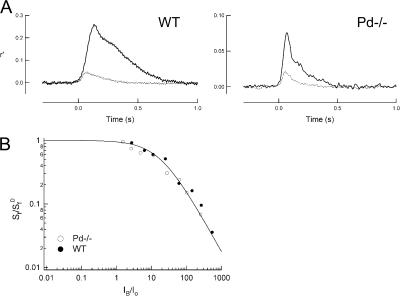Figure 6.
Adaptation of incremental flash sensitivity is normal in Pd−/− rods. (A) Average dim flash responses (r′; in pA) delivered in darkness (solid) or in the presence of steady light (dash) that decreased the circulating (dark) current by ∼75%. In both WT and Pd−/− rods, steady light decreased the response amplitude and slightly accelerated the response time course as previously described (e.g., Krispel et al., 2003). Dark currents (in pA) were 16.2 (WT) and 16.1 (Pd−/−). (B) Flash sensitivity in background light (Sf) was normalized by the dark-adapted flash sensitivity (Sf D), measured before and after each background light intensity. The x-axis was normalized by the average Io values for WT and Pd−/− rods, which caused the two relations to superimpose, indicating that Pd does not contribute directly to the changes in flash sensitivity that accompany background illumination. Points reflect mean values, with the number of cells varying between 2 and 7 for WT and 2 and 10 for Pd−/−.

